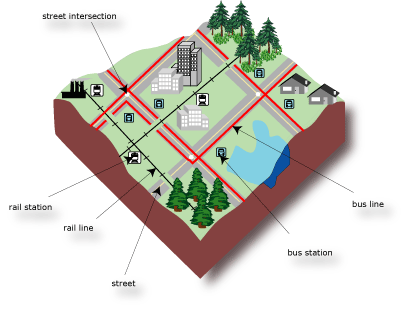Available with Network Analyst license.
Network datasets are made of network elements. Network elements are generated from the source features used to create the network dataset. The geometry of the source features helps establish connectivity. In addition, network elements have attributes that control navigation over the network.
There are three kinds of network elements:
- Edges—Connect to other elements (junctions) and are the links over which agents travel
- Junctions—Connect edges and facilitate navigation from one edge to another
- Turns—Store information that can affect movement between two or more edges
Edges and junctions form the basic structure of any network. Connectivity in a network deals with connecting edges and junctions to each other. Turns are optional elements that store information about a particular turning movement; for instance, a left turn is restricted from one particular edge to another.
Network sources
There are three types of network sources that can participate in the creation of a network dataset:
- Edge feature sources—Line feature classes participate as edge feature sources.
- Junction feature sources—Point feature classes can participate as junction feature sources, but multipoint feature classes cannot.
- Turn feature sources—Turn feature classes participate as turn feature sources in a network. A turn feature source explicitly models a subset of possible transitions between edge elements during navigation.
Each feature class that participates in a network as a source generates elements based on its assigned role. For example, a line feature class is used as a source for edge elements, and a point feature class is used to generate junction elements. Turn elements are created from a turn feature class. The generated junction, edge, and turn elements form the underlying graph, which is the network.
Geometric network feature classes cannot participate as network dataset sources because they are actively linked to a geometric network. Feature classes that participate as a source in a network dataset can participate in a topology.
Consider the example of a simple transportation network and the sources that participate in its creation. This network has a streets feature class that can act as an edge source, a street intersections feature class acting as a junction source, additional line feature classes that act as edges (rail lines and bus routes), and point feature classes that act as junctions (rail stations and bus stations).

All feature classes that reside in the feature dataset, which contains the network dataset, can participate as network sources. Only two sources can participate in a shapefile network dataset—a line shapefile and a shapefile turn feature class.
System junctions
A junction must exist at each end of an edge in a network dataset. So if you don't create a junction source feature at the end of an edge, a system junction will be created automatically for you when the network dataset is built.
System junctions are stored as points in a source feature class, which is automatically generated during the first build operation. The source feature class is named [network name]_Junctions, where [network name] represents the name of the network dataset.